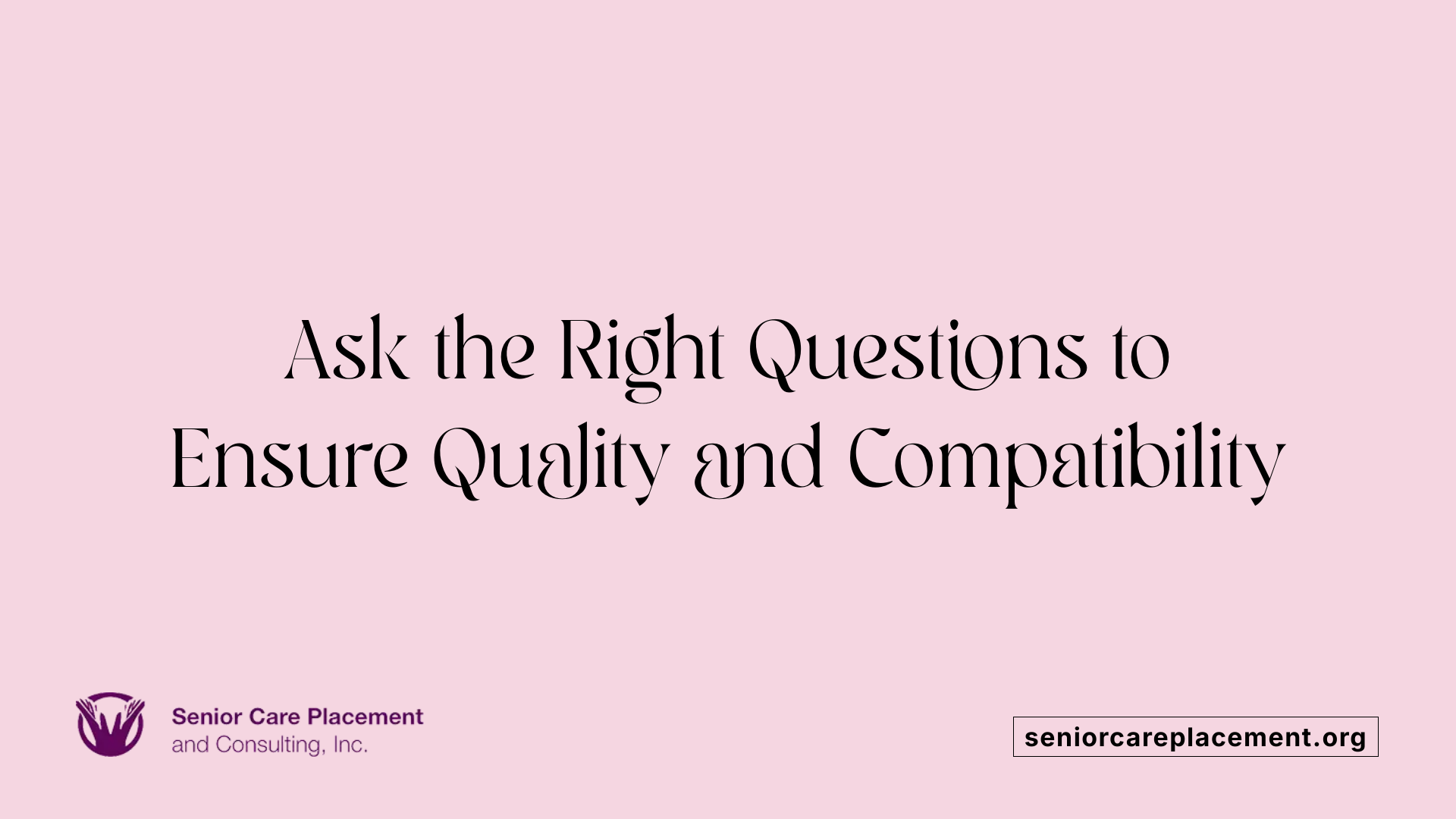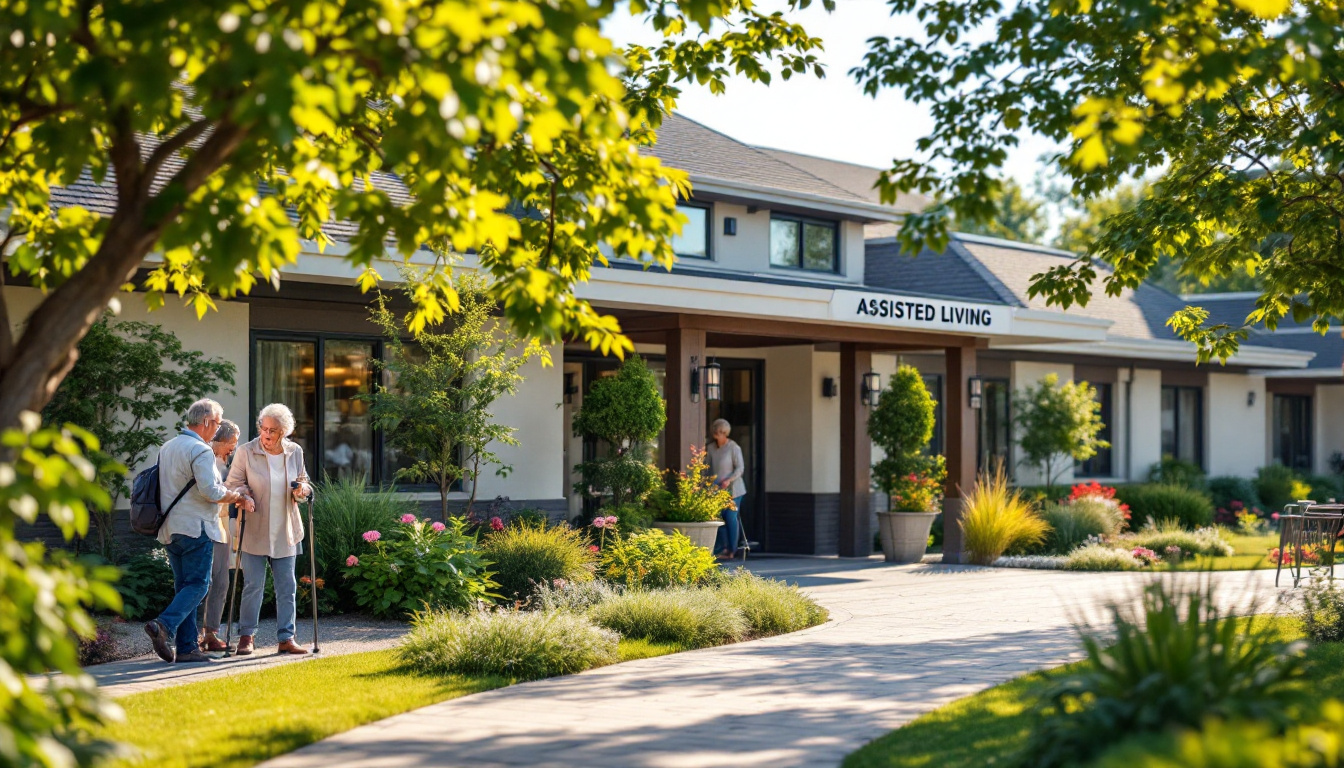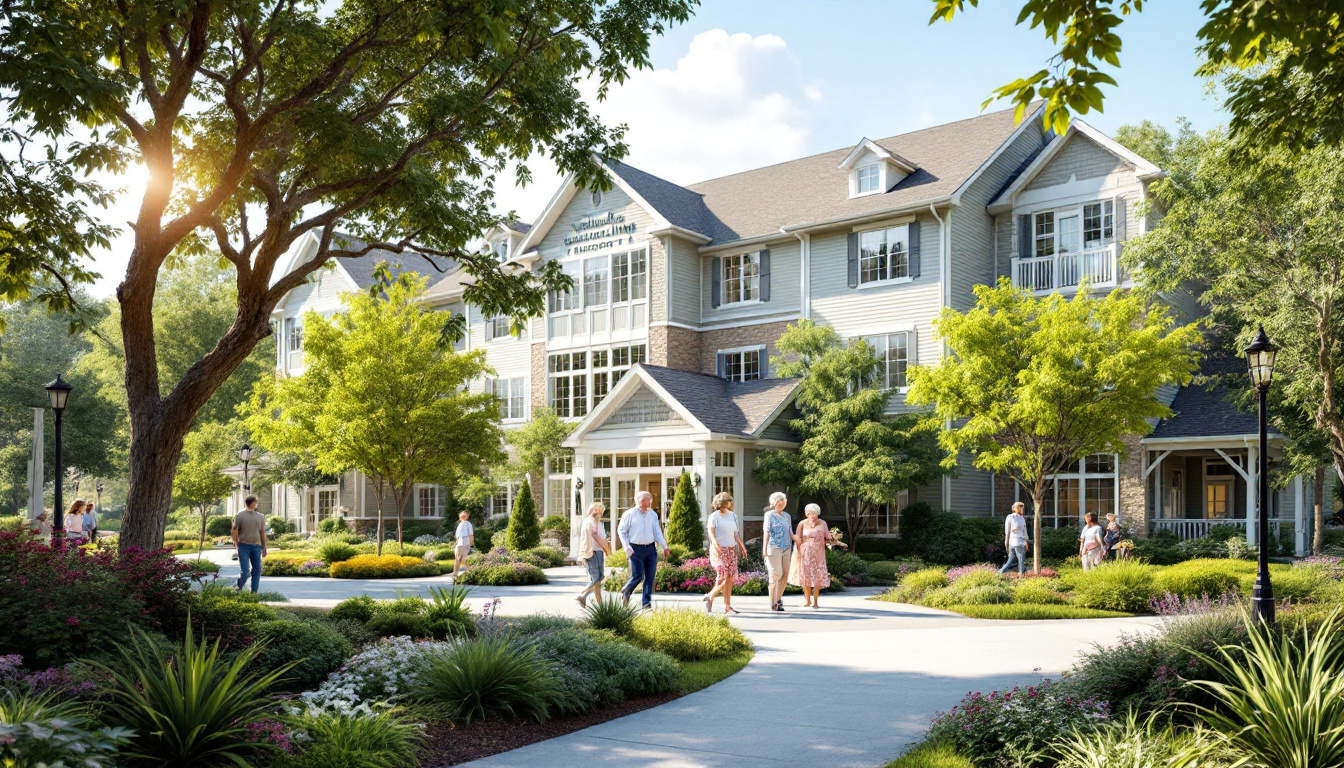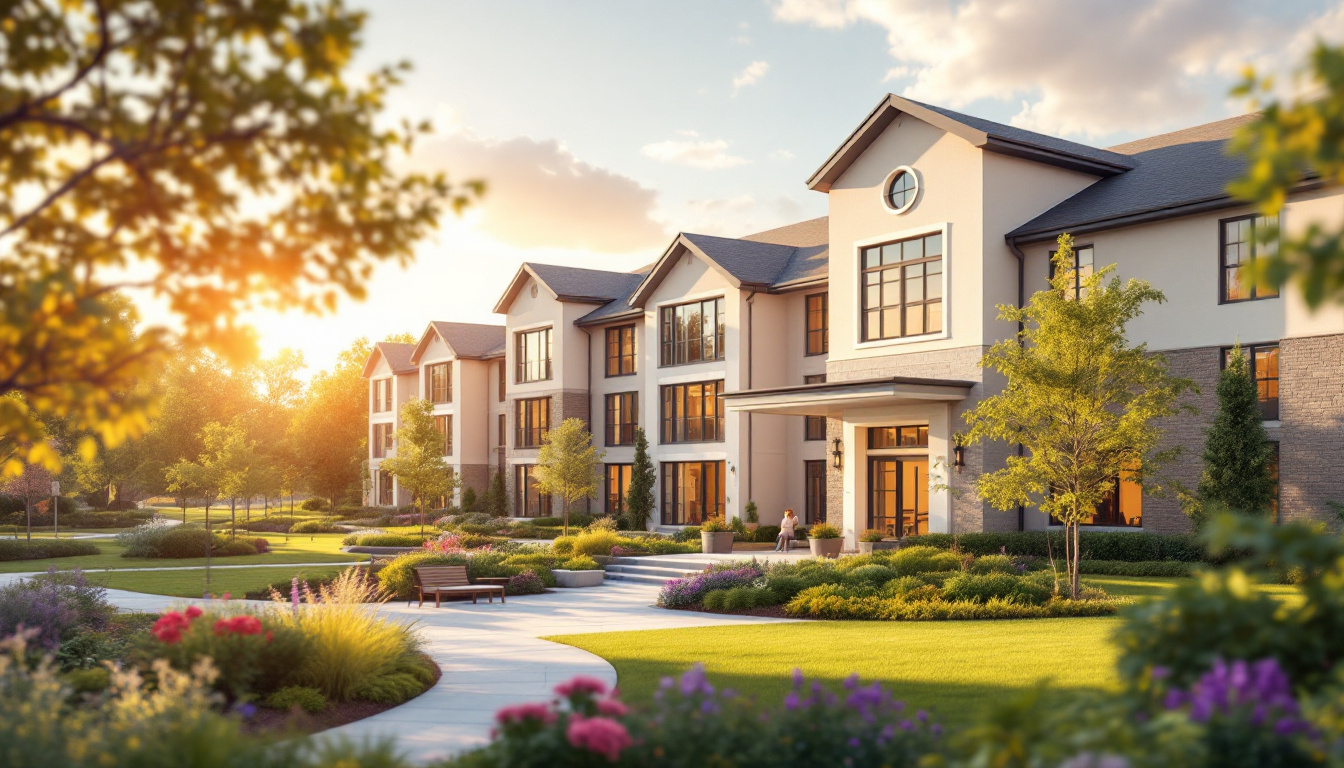How to Choose the Right Senior Care Facility for Your Loved One
Guiding Your Choice Towards Quality Senior Living

Understanding the First Steps in Selecting a Care Facility
Choosing the right senior care facility is a critical decision that involves assessing the unique needs of your loved one and understanding the spectrum of available options. A thorough and personalized approach ensures that seniors receive appropriate care while maintaining dignity, safety, and quality of life. This guide explores the essential factors, key considerations, and practical steps necessary for making an informed choice that aligns with both care requirements and personal preferences.
Assessing Individual Care Needs for Optimal Placement

How can I assess the care needs of a senior to determine appropriate senior care options?
Evaluating a senior’s care requirements is a vital step in choosing the right long-term care environment. This process involves examining various aspects of their health and daily functioning. Typically, a multidisciplinary team, including healthcare providers, social workers, and family members, conducts a comprehensive assessment.
The evaluation considers physical health issues, mobility limitations, personal hygiene, medication management, safety features, cognitive abilities, emotional well-being, and social engagement. Collecting detailed personal history and understanding the senior’s preferences are also crucial.
Using specialized assessment tools can help quantify needs and highlight areas requiring support. For example, checklists and standardized scales can track changes over time, such as weight loss, increased fall risk, or social withdrawal.
Monitoring these indicators regularly allows families and professionals to adjust care plans proactively. Reassessments can identify the need for more assistance or a different type of care, such as transitioning from independent living to assisted living or nursing care.
By accurately assessing individual needs, families can make informed decisions that ensure their loved ones receive appropriate, personalized support tailored to their evolving health and lifestyle requirements.
Key Factors and Considerations When Choosing a Facility

What are the key factors and considerations when choosing a senior care facility?
Selecting the right senior care facility requires careful evaluation of multiple aspects to ensure it meets both current and future needs of the individual. First, it’s important to match the level of care provided with the resident’s present health status and anticipate possible future requirements, such as assistance with activities of daily living, medical management, or memory care.
Safety features are crucial. Facilities should have measures like grab bars, emergency call systems, wheelchair ramps, and clear signage. Additionally, review staff qualifications, including training, background checks, and turnover rates, as consistent, well-trained staff contribute significantly to quality care.
Touring several facilities offers valuable insights. Pay attention to cleanliness, resident interactions, staff responsiveness, and overall atmosphere. During visits, ask specific questions about safety protocols, staff competency, health oversight, and the availability of specialized units.
Understanding the facility’s reputation is also essential. Consult reviews, speak with current residents and families, and verify licensing and compliance with local regulations. Transparency regarding costs and contracts is vital—review all fees, insurance policies, optional services, and any potential hidden or future charges.
Additional considerations include the amenities and social activities offered. Look for engaging programs that promote physical, mental, and social well-being. Food services, living accommodations, and outdoor spaces should support a comfortable and active lifestyle.
Lastly, consider the facility’s location relative to family and healthcare providers. Proximity allows for easier visits, ongoing support, and swift access to medical care. Overall, choosing a community that aligns with the individual’s health needs, personal preferences, and financial situation will lead to a more satisfying and secure living environment.
Understanding Types of Senior Care Facilities and Their Features

What types of senior care facilities are available and what are their features?
Seniors have a variety of care options tailored to their health, mobility, and personal preferences. Each type of facility offers different levels of support and amenities.
Independent living communities are designed for healthy seniors who want an active lifestyle without needing daily assistance. These communities typically feature private apartments, social activities, dining services, and transportation, allowing residents to enjoy independence with the convenience of community support.
Assisted living facilities provide help with daily activities such as bathing, dressing, medication management, and housekeeping. They aim to balance support and independence, offering personalized care plans and social opportunities in a supportive environment.
For seniors with complex medical needs or recovery requirements, nursing homes or skilled nursing facilities deliver around-the-clock medical supervision. These sites are equipped with nursing staff, rehabilitation services, and specialized medical equipment.
Memory care units are dedicated spaces within larger facilities, designed specifically for individuals with Alzheimer’s disease or other dementias. They feature secure environments, staff trained in cognitive impairments, and therapeutic activities tailored to residents' mental health needs.
Other options include in-home care services, which enable seniors to remain in their familiar environment while receiving support for personal care and household tasks. Continuing Care Retirement Communities (CCRCs) offer multiple levels of care—independent, assisted living, and nursing care—on one campus, allowing residents to age in place as their needs change.
In conclusion, understanding these options helps families choose the most suitable environment for their loved ones, ensuring safety, comfort, and a fulfilling lifestyle at every stage of aging.
Effective Questions to Ask During Facility Visits

What questions should I ask during facility visits to evaluate their suitability and quality of care?
When visiting a senior care facility, it’s important to ask comprehensive questions that give you a clear picture of the quality of care and the environment. Start with questions about staff qualifications, training, and staffing ratios. Find out how many staff members are on duty at different times and whether they have ongoing training in areas like medication management, emergency procedures, and resident care.
Inquire about safety measures and protocols, including emergency response plans, the presence of safety equipment such as grab bars and wheelchair ramps, and overall cleanliness. Observe for resident engagement and social activities, and ask how the community promotes social and physical activity.
Understanding the care planning process is essential. Ask how personalized care plans are developed, reviewed, and updated. Clarify whether residents or their families participate in creating these plans and what healthcare services are available on-site—such as medication management, nursing care, physical therapy, or mental health support.
Discuss costs thoroughly. Request detailed billing information, including monthly fees, charges for additional services, and policies on deposits or potential fees increases. Ensure you understand the contract terms and inquire about protections against unexpected charges or discharge policies.
Finally, observe the general atmosphere of the facility. Talk to residents and staff, if possible, to gauge satisfaction levels. Look at the condition of common areas, dining spaces, and bedrooms. Confirm that the facility complies with all safety regulations and standards, such as fire safety measures and health inspections.
By asking these targeted questions, you equip yourself with the knowledge necessary to determine if a facility will meet your loved one’s needs and provide a safe, engaging, and supportive environment.
Involving Loved Ones in the Care Decision Process

How can I involve loved ones in the decision-making process for senior care?
Engaging loved ones early in the process of selecting a long-term care facility is essential for making choices that truly reflect their needs and preferences. Begin with open, honest conversations that share vital information about the senior’s health, daily living habits, and personal wishes.
Discussing values, future goals, and healthcare directives helps to establish a shared understanding and ensures the senior’s autonomy remains respected. It’s helpful to involve the individual in touring potential facilities and participating in meetings with staff, so they feel invested and comfortable with the decision.
Designating a trusted family member as a healthcare proxy or power of attorney streamlines decision-making should the senior become unable to communicate. Using legal tools like advance directives and living wills can clarify preferences regarding medical treatments and end-of-life care.
Regularly scheduled family meetings foster ongoing dialogue. These discussions allow family members to ask questions, express concerns, and adapt plans as needs evolve. Maintaining organized records of medical histories, treatment preferences, and legal documents simplifies the decision-making process.
Consulting healthcare professionals, social workers, or senior care advisors can provide expert guidance and help interpret complex care options. Approaching all conversations with sensitivity, empathy, and patience strengthens trust and collaboration, leading to more informed and satisfying decisions for everyone involved.
Financial Planning and Cost Management for Senior Care

What are the cost considerations and financial planning strategies for senior care?
Planning for senior care involves understanding various expenses and developing effective financial strategies. Costs can vary widely depending on the type of care needed, whether it is assisted living, skilled nursing, memory care, or other services. It's crucial to assess the monthly fees, charges for extra services, and potential hidden costs such as transportation, medications, or specialized therapies.
Maximizing income sources is a vital part of financial planning. Seniors should explore benefits from Social Security, pension plans, retirement savings, and other income streams. Insurance options such as Medicare, Medigap policies, and long-term care insurance can help cover healthcare and care facility costs. Reviewing these options early can prevent surprises and ensure suitable coverage.
Estate management is also an important consideration. Establishing legal documents like wills, trusts, powers of attorney, and advance directives ensures that assets are protected and healthcare wishes are respected. Engaging with legal professionals can help craft these documents tailored to individual needs.
Proactive planning extends to safeguarding assets from fraud or financial exploitation, which can be common among vulnerable seniors. Strategies may include asset protection trusts or reverse mortgages if appropriate.
Creating a detailed budget that includes ongoing costs helps maintain financial stability. Regular reviews of the financial plan—adjusting for inflation and changing care needs—are essential. It also fosters open conversations with loved ones about finances and care preferences.
Utilizing tools like long-term care insurance, government assistance programs, and community resources can ease the financial burden. Proper planning ensures that seniors receive quality care without compromising their financial security.
In summary, effective financial planning for senior care combines understanding costs, optimizing income sources, protecting assets, and planning for the future through legal arrangements. Beginning this process early makes navigating the complex eldercare landscape more manageable and less stressful.
Recognizing the Signs for Transition to Assisted Living or Senior Services
 Understanding when it’s time to consider assisted living or senior care services is crucial for ensuring safety and well-being. Several signs can signal that a loved one might need additional support.
Understanding when it’s time to consider assisted living or senior care services is crucial for ensuring safety and well-being. Several signs can signal that a loved one might need additional support.
One of the most apparent indicators is a decline in the ability to perform daily activities independently. If a person begins struggling with tasks such as bathing, dressing, cooking, or managing medications, it suggests their level of independence is diminishing. These difficulties may lead to increased risk of accidents or health complications.
Safety hazards within the home are another critical concern. Frequent falls, difficulties navigating stairs, wandering behaviors, or cluttered environments that increase fall risks are clear signs that a safer, monitored setting is needed. Regular accidents or near-misses highlight the importance of a secure environment.
Cognitive and behavioral changes also serve as key indicators. Signs such as confusion, forgetfulness, or memory lapses that interfere with medication management or daily routines often point toward cognitive decline or conditions like dementia. Recognizing these changes early allows for timely intervention.
Social isolation, loneliness, or visible signs of depression can negatively impact mental health. If a loved one becomes increasingly withdrawn or disengaged from social activities, assisted living communities with organized social, recreational, and therapeutic activities can greatly improve their quality of life.
Furthermore, caregiver burnout and health deterioration are significant reasons to seek professional care. When family caregivers experience emotional, physical, or mental exhaustion that hampers their ability to provide adequate care, or if their own health declines, transitioning to a senior community provides relief and ensures proper care.
In summary, declining independence, safety concerns, cognitive and behavioral changes, social withdrawal, and caregiver strain are all signs that it may be time to explore assisted living or other senior services. Early recognition and action help maintain dignity, safety, and quality of life for seniors.
Search for more information using the query: "signs for moving to assisted living" to find additional resources and support options.
Utilizing Resources, Checklists, and Building a Support Network
Are there resources and checklists available for evaluating senior care options?
Yes, there are numerous resources and checklists designed to assist families and caregivers in evaluating senior care choices effectively. These tools serve as structured guides during site visits, helping to assess cleanliness, safety features, staff interaction, and level of resident engagement.
Many organizations, including government agencies like the Medicare and Medicaid services, the NIH, and eldercare advocacy groups, offer downloadable checklists. These often cover key aspects such as safety standards, facility cleanliness, staff qualifications, medical and social services, costs, and accessibility features.
Using these checklists, families can systematically compare potential facilities or in-home services, ensuring that all critical factors are considered. For example, checklists may include questions about staff training, resident safety protocols, activity programs, meal services, and regulatory compliance.
Apart from physical site evaluations, online tools and guides are available for broader assessments. Several websites provide detailed comparison features for senior living communities, including ratings, reviews, and cost estimators. These digital resources often include filters based on location, care level, and amenities, simplifying the search process.
Overall, leveraging these available checklists and online tools enables more thorough and informed decision-making. They help identify the best fit according to the care needs, safety standards, financial considerations, and personal preferences of the senior adult. Preparing in advance with these guides promotes confidence and clarity, ensuring that the chosen environment promotes well-being and quality of life for the elderly individual.
Physical Environment, Safety Measures, and Quality Indicators
What safety, amenities, and quality indicators should I consider in selecting a facility?
When choosing a long-term care facility, safety features are a critical consideration. Ensure the facility has safety amenities like grab bars in bathrooms, wheelchair ramps, wide doorways, and clear signage for emergency exits. These features help prevent accidents and promote independence.
Regular inspections and strict safety standards are essential indicators of quality. Look for facilities that undergo routine safety checks, maintain high cleanliness standards, and adhere to infection control protocols. Evidence of compliance might include certifications or inspection reports available on licensing authority websites.
Staff qualifications and care quality also significantly influence safety. A high caregiver-to-resident ratio, comprehensive staff training, and background checks are vital. Staff should be well-trained in emergency procedures, medication management, and resident safety protocols.
Resident satisfaction is a strong indicator of overall quality. Feedback from residents and families—collected through surveys or informal conversations—can reveal issues related to responsiveness, cleanliness, and staff attentiveness. Monitoring health outcomes such as low infection rates, minimal pressure ulcers, and effective medication administration further reflects high-quality care.
Sources like Medicare provide publicly available ratings based on inspection results, staffing levels, and care quality. These ratings serve as helpful tools for comparing facilities objectively.
Finally, comprehensive programs that promote social engagement, nutritious meals, mental health support, and personalized care plans contribute to a safe and nurturing environment. These indicators collectively ensure residents' safety, well-being, and active participation in community life.
Making an Informed Choice for a Comfortable Future
Selecting the right senior care facility involves a detailed evaluation of care needs, facility features, safety standards, and personalized preferences. Engaging actively with potential communities through tours, questions, and personal visits allows families to gauge the environment and staff competence, ensuring that the chosen facility supports the senior’s physical health, emotional well-being, and lifestyle desires. Involving your loved one throughout the process fosters a sense of autonomy and comfort, easing the transition and promoting satisfaction. Financial planning and resource utilization are integral to making sustainable decisions, as is ongoing assessment to adapt to changing needs. Ultimately, thorough research and thoughtful engagement help families find a care environment where their loved ones will feel safe, supported, and valued, laying the groundwork for a positive and fulfilling aging experience.
References
- How To Choose a Nursing Home or Other Long-Term Care Facility
- Key Questions to Ask During an Assisted Living Facility Tour
- How to Choose the Right Senior Living Community
- 7 Steps to Choose the Right Care Facility for Your Loved One
- How to Choose the Best Elder Care Facility for Your Loved Ones
- How to Choose the Right Senior Living Community for Your Loved ...
- How to Choose the Right Senior Living Facility: A Checklist - Health






































































































